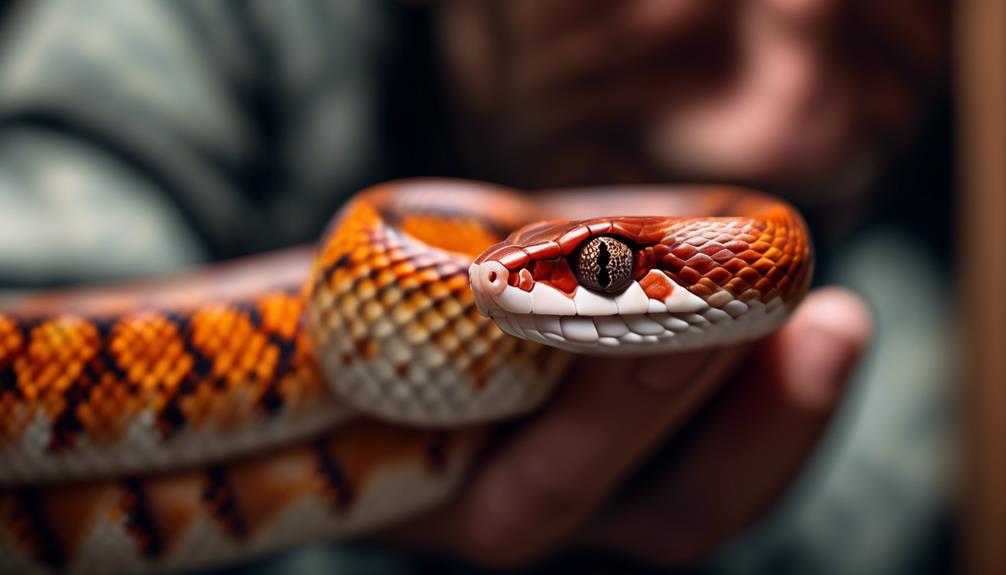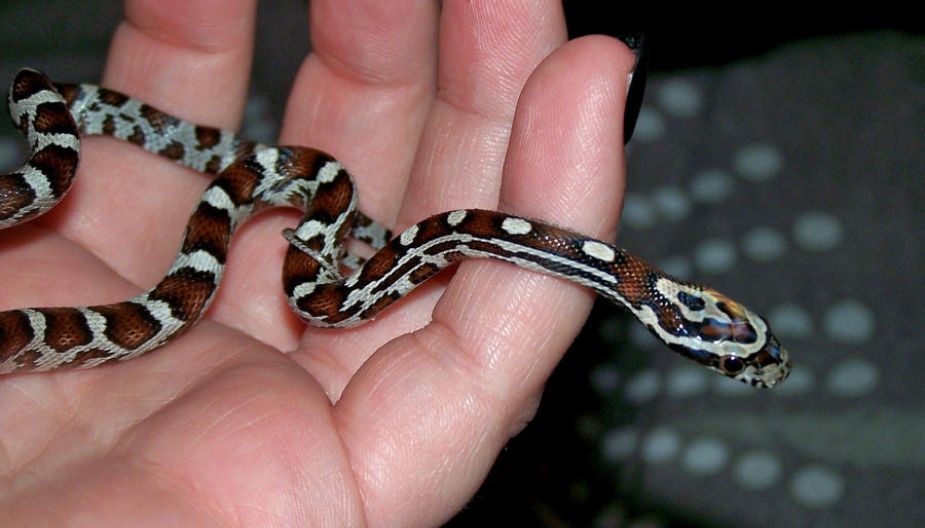Have you ever wondered why your corn snake seems nervous or hesitant to be handled? You're not alone in facing this common challenge with pet corn snakes.
Understanding how to handle and tame a nervous corn snake requires patience, knowledge, and a gentle approach. By learning the best handling tips and techniques, you can help your tiny terror feel more comfortable and secure in your care.
Understanding Your Corn Snake's Behavior
When observing your corn snake's behavior, it's important to be attentive to its body language and movements as they can provide valuable insights into its health and well-being. Corn snakes communicate through various body language cues, which can indicate stress or discomfort. Stress signals in corn snakes may include rapid or erratic movements, hissing, and coiling into tight balls. When a corn snake feels threatened or stressed, it may also exhibit defensive behaviors such as striking or flattening its body to appear larger. These signs are important to recognize, as they can help you adjust your handling approach to minimize stress for your pet.
Understanding your corn snake's body language is crucial for building a trusting relationship and ensuring its well-being. By carefully observing its movements and reactions, you can learn to interpret its signals and respond appropriately. This won't only help reduce stress for your corn snake but also allow you to provide the best care possible.
Being attuned to your corn snake's body language is an essential aspect of responsible snake ownership, contributing to its overall health and happiness.
Creating a Safe and Calming Environment
Creating a safe and calming environment for your nervous corn snake is essential for promoting its well-being and minimizing stress. Corn snakes, like many reptiles, thrive in environments that mimic their natural habitat, providing a cozy, secure hiding spot and minimizing environmental stressors. To achieve this, consider the following key elements when setting up your corn snake's enclosure:
| Aspect | Description |
|---|---|
| Substrate | Choose a substrate such as aspen bedding or coconut husk, which allows for burrowing and helps maintain proper humidity levels. |
| Temperature | Maintain a thermal gradient with a warm side (85-90°F) and a cooler side (70-75°F) to allow your snake to regulate its body temperature. Use a thermostat to ensure temperature consistency. |
| Hiding Places | Provide at least two secure hiding spots, one on the warm side and one on the cool side, using artificial caves or half logs to create a sense of security and reduce stress. |
Gradual Introduction to Handling
For a nervous corn snake, a gradual introduction to handling is crucial for building trust and reducing stress. Here are three key steps to help you with this process:
- Building Confidence: Start by simply placing your hand inside the snake's enclosure for a few minutes each day. This allows the snake to become accustomed to your presence and scent without feeling threatened. Over time, the snake will become more comfortable with your hand being in its space.
- Gentle Approach: When the snake seems more at ease with your hand in its enclosure, you can gently stroke its back with slow, smooth motions. This helps the snake associate your touch with a sense of safety and comfort. Be patient and observant of the snake's body language to ensure that you're not causing any distress.
- Gradual Handling: Once the snake shows signs of reduced stress, you can begin to handle it for short periods. Support its body properly and avoid sudden movements. Gradually increase the duration of these handling sessions as the snake becomes more accustomed to being held.
Building Trust Through Positive Reinforcement
After establishing a foundation of comfort and trust through gradual handling, positive reinforcement techniques can further solidify the bond between you and your nervous corn snake. Trust building techniques are essential for nurturing a positive relationship with your snake.
When engaging in positive reinforcement, it's important to use rewards such as favorite foods, gentle handling, and calm interactions to encourage desired behaviors. For instance, when your snake willingly explores your hand or stays calm during handling, offer a small treat or a gentle stroke as a form of positive reinforcement.
Consistency is key in positive reinforcement strategies. By consistently rewarding desirable behaviors and avoiding punishment, your corn snake will learn to associate handling with positive experiences. This will help reduce its nervousness over time.
Additionally, it's crucial to be patient and attentive to your snake's body language. Understanding your snake's comfort level and responding accordingly will contribute to building trust. Remember that positive reinforcement should always be paired with patience, respect, and understanding of your snake's individual needs.
Through these methods, you can establish a strong foundation of trust and companionship with your nervous corn snake.
Overcoming Common Handling Challenges
To address common handling challenges with nervous corn snakes, it's important to observe their behavior and gradually acclimate them to regular handling routines. Building confidence and reducing anxiety in these snakes can be achieved through the following techniques:
- Consistent Handling: Establish a regular handling routine to help your corn snake become familiar and comfortable with human interaction. Start with short, gentle handling sessions and gradually increase the duration as the snake grows more accustomed to being held.
- Creating a Safe Environment: Ensure that the snake's habitat provides adequate hiding spots and temperature gradients. This will help reduce stress and make the snake feel secure, ultimately aiding in its overall comfort and confidence.
- Positive Reinforcement: Use positive reinforcement techniques, such as offering food or treats after handling, to create a positive association with human interaction. This can help reduce the snake's anxiety and encourage it to feel more at ease during handling sessions.
Conclusion
Now that you have learned the tips for handling nervous corn snakes, remember that patience and consistency are key.
For example, one owner gradually introduced their nervous corn snake to handling by starting with short, positive interactions and slowly increasing the duration over time.
By creating a safe and calming environment and using positive reinforcement, they were able to build trust and overcome common handling challenges.
With dedication, you can help your tiny terror become a confident and content corn snake.


